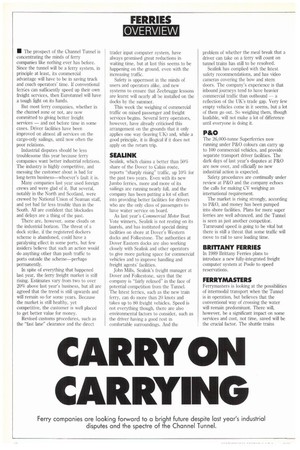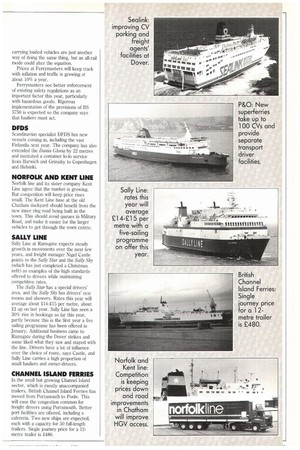CARRY ON CARRYING
Page 48

Page 49

If you've noticed an error in this article please click here to report it so we can fix it.
Ferry companies are looking forward to a bright future despite last year's industrial disputes and the spectre of the Channel Tunnel.
• The prospect of the Channel Tunnel is concentrating the minds of ferry companies like nothing ever has before. Since the tunnel will be a ferry system, in principle at least, its commercial advantage will have to be in saving truck and coach operators' time. If conventional ferries can sufficiently speed up their own freight services, then Eurotunnel will have a tough fight on its hands.
But most ferry companies, whether in the channel zone or not, are now committed to giving better freight services — and not before time in some cases. Driver facilities have been improved on almost all services on the cargo-only sailings, until now often the poor relations.
Industrial disputes should be less troublesome this year because ferry companies want better industrial relations. The industry is highly competitive, and messing the customer about is had for long-term business—whoever's fault it is.
Many companies last year used foreign crews and were glad of it. But several, notably in the North and Scotland. were crewed by National Union of Seaman staff, and vet had far less trouble than in the South. All are confident that blockades and delays are a thing of the past.
There are, however, some clouds on the industrial horizon. The threat of a dock strike, if the registered dockers scheme is abandoned, could have a paralysing effect in some ports. but few insiders believe that such an action would do anything other than push traffic to ports outside the scheme—perhaps permanently.
In spite of everything that happened last year, the ferry freight market is still rising. Estimates vary from two to over 20% above last year's business, but all are agreed that the trend is still upwards and will remain so for some years. Because the market is still healthy, yet competitive, the customer is well placed to get better value for money.
Revised customs procedures, such as the "fast lane" clearance and the direct trader input computer system, have always promised great reductions in waiting time, but at last this seems to be happening on the ground, even with the increasing traffic.
Safety is uppermost in the minds of users and operators alike, and new systems to ensure that Zeebrugge lessons are learnt will nearly all be installed on the docks by the summer.
This week the weighing of commercial traffic on mixed passenger and freight services begins. Several ferry operators, however, have already criticised this arrangement on the grounds that it only applies one way (leaving UK) and, while a good principle, it is illogical if it does not apply on the return trip.
SEALINK
Sealink, which claims a better than 50% share of the Dover to Calais route, reports "sharply rising" traffic, up 10% for the past two years. Even with its new Jumbo ferries, more and more of its sailings are running nearly full, and the company has been putting a lot of effort into providing better facilities for drivers who are the only class of passengers to have waiter service on board.
As last year's Commercial Motor Boat Vote winners, Sealink is not resting on its laurels, and has instituted special dining facilities on shore at Dover's Western docks and Folkestone. The authorities at Dover Eastern docks are also working closely with Sealink and other operators to give more parking space for commercial vehicles and to improve handling and freight agents' facilities.
John Mills, Sealink's freight manager at Dover and Folkestone, says that the company is "fairly relaxed" in the face of potential competition from the Tunnel. The latest ferries, such as the new train ferry, can do more than 20 knots and takes up to 80 freight vehicles. Speed is not everything though, there are also environmental factors to consider, such as the driver having a good rest in comfortable surroundings. And the problem of whether the meal break that a driver can take on a ferry will count on tunnel trains has still to be resolved.
Sealink has complied with the latest safety recommendations, and has video cameras covering the bow and stern doors. The company's experience is that inbound journeys tend to have heavier commercial traffic than outbound — reflection of the UK's trade gap. Very few empty vehicles come in it seems, but a lot of them go out. So weighing them, though laudable, will not make a lot of difference until everyone is doing it.
The 26,000-tonne Superferries now running under P&O colours can carry up to 100 commercial vehicles, and provide separate transport driver facilities. The dark days of last year's disputes at P&O are now over, and officially no new industrial action is expected.
Safety procedures are continually under review at P&O and the company echoes the calls for making CV weighing an international requirement.
The market is rising strongly, according to P&O, and money has been pumped into shore facilities. Plans for more super ferries are well advanced, and the Tunnel is seen as just another competitor. Turnround speed is going to be vital but there is still a threat that some traffic will move to rail to save loading time.
BRITTANY FERRIES
In 1989 Brittany Ferries plans to introduce a new fully-integrated freight computer system at Poole to speed reservations.
FERRYMASTERS
Ferrymasters is looking at the possibilities of intermodai transport when the Tunnel is in operation, but believes that the conventional way of crossing the water will remain predominant. There will, however, be a significant impact on some services and cost, not time, saved will be the crucial factor. The shuttle trains carrying loaded vehicles are just another way of doing the same thing, but an all-rail mode could alter the equation.
Prices at Ferrymasters will keep track with inflation and traffic is growing at about 10% a year.
Ferrymasters see better enforcement of existing safety regulations as an important factor this year, particularly with hazardous goods. Rigorous implementation of the provisions of BS 5750 is expected so the company says that hauliers must act.
DFDS
Scandinavian specialist DFDS has new vessels coming in, including the vast Finlandia next year. The company has also extended the Dania Gloria by 22 metres and instituted a container lo-lo service from Harwich and Griinsby to Copenhagen and Helsinki.
NORFOLK AND KENT LINE
Norfolk line and its sister company Kent Line agree that the market is growing. But competition will keep price rises small. The Kent Line base at the old Chatham dockyard should benefit from the new inner ring road being built in the town. This should avoid queues in Military Road, and make it easier for the larger vehicles to get through the town centre.
SALLY LINE
Sally Line at Ramsgate expects steady growth in movements over the next few years, and freight manager Nigel Castle points to the Sally Star and the Sally Sky (which has just completed a Christmas refit) as examples of the high standards offered to drivers while maintaining competitive rates.
The Sally Star has a special drivers' area, and the Sally Sky has drivers' rest rooms and showers. Rates this year will average about .214415 per metre, about £1 up on last year. Sally Line has seen a 30% rise in bookings so far this year, partly because this is the first year a five sailing programme has been offered in January. Additional business came to Ramsgate during the Dover strikes and some liked what they saw and stayed with the line. Drivers have a lot of influence over the choice of route, says Castle, and Sally Line carries a high proportion of small hauliers and owner-drivers.
CHANNEL ISLAND FERRIES
In the small but growing Channel Island sector, which is mostly unaccompanied trailers, British Channel Island Ferries has moved from Portsmouth to Poole. This will ease the congestion common for freight drivers using Portsmouth. Better port facilities are offered, including a cafeteria. Two new ships are expected, each with a capacity for 50 full-length trailers. Single journey price for a 12metre trader is 2480.












































































































